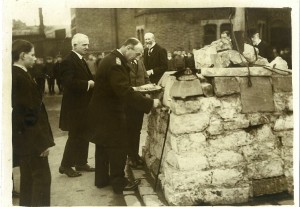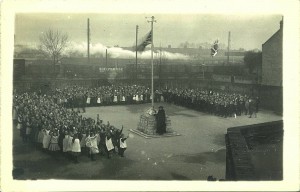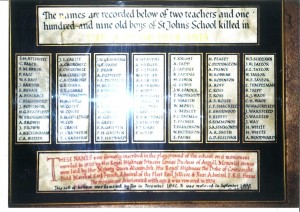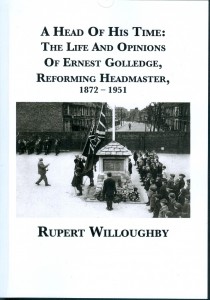
Admiral Lord Jellicoe lays one of the four corner stones of the St John's School War Memorial Cairn, 22 January 1918
The personal archive of Ernest Golledge reveals the effect of the First World War on the life of St John’s Boys’ Elementary School in Ealing, of which he was the inspirational headmaster.
Perhaps the first impact of the war was the departure, on 14 November 1914, of one of its masters, enrolled as an instructor in the ‘New Model Army’. The second was an increased number of visitors in uniform. Adept at attracting ‘celebrities’ into the school – he had even persuaded Shackleton to give a talk there – he soon arranged visits by Lieutenant-Commander Norman Holbrook, V.C. – ‘a real schoolboy’s hero, a man of the sea, sunburnt, jolly and breezy’ – and an old friend, an habitué of the nearby Hendon Aerodrome, Lieutenant Louis Noel of the French Flying Corps.
With mounting casualties among old boys, Ernest soon decided to erect a war memorial in the playground, one of the earliest to be raised, and to have some of its stones placed in position by visiting dignitaries. The first of these was the Hon. J.G. Jenkins, late Premier of Australia. Most of the heavy stones had been lifted into place by the boys themselves. A number of wounded soldiers, some with their arms in slings, were on hand to witness the ceremony.
In October 1916, Ernest invited no less a personage than Field Marshal Lord French, commander-in-chief of the British Home Forces, to ‘fix a corner stone on the “Cairn”’. Surprisingly, Lord French was ‘very much inclined to accede to your request’. His visit, postponed till 19 September 1917, despite much badgering from Ernest, lasted a mere ‘quarter of an hour’, during which he pinned the Distinguished Conduct Medal on the chest of a St John’s old boy. Private William Bristow of the Rifle Brigade, whom Ernest described as ‘an average type of boy’, had crawled under German wire entanglement at Armentières to lob a grenade into a crowded trench, and was to spend two and a half years in hospital for his pains.

Princess Louise stands by the unfinished War Memorial. This was probably her first visit to St John's, in 1916
The patriotic Ernest encouraged his boys to invest in the ‘War Loan’, an initiative in which children all over the country were involved. H.R.H. the Princess Louise lent her support and duly visited the school. She returned in the autumn of 1917 with her brother, the Duke of Connaught, who applied ‘a quantity of cement’ to the cairn before unveiling a portrait of Lord Kitchener. In January 1918, it was pointed out in the press that special significance was attached to the four corner stones of the cairn. Three of these had been laid by Lord French, the Duke of Connaught and Lord Jellicoe. Ernest was said to have in mind the Chief of Staff, General Sir William Robertson, to lay the fourth. In the event, it was Haig himself who performed the duty, probably late in 1920.
It is disillusioning to find a far from united home front. Every headmaster was obsessed with attendance figures. With much of the working population away at the front, able-bodied schoolboys were in high demand as workers. As a result, the self-interested tradesmen of Ealing had lured almost a quarter of Ernest’s boys from their classrooms – illegally – and, by December 1916, he was barely managing to hold the school together. A cynical, or pragmatic Mayor had instructed the attendance officer to turn a blind eye to the ‘wholesale employment of boys – as errand boys’, which had eventually reduced the school roll by nearly a quarter.
A lack of sufficient fuel that winter, an exceptionally harsh one, would hardly have helped. On 5 February 1917 the temperature in the unheated classrooms fell below freezing. The only option for the shivering boys was a lesson in ‘Drill’. Ernest caught a ‘severe chill’, as did ‘several of the teachers’ and ‘many of the children’. Such conditions were not just to be endured for a single day, but for weeks on end. ‘No fires in afternoon and no coal although plenty on order. Secretary informed.’ There is little sense of a community pulling together in adversity. Ernest seems almost to have been abandoned by the school managers, the local authority and by the townsfolk in general. Thefts at the school – of an umbrella, coats and Ernest’s own bicycle – were a further irritant.
In addition, there was the general disruption that came from being in a state of war. On 3 October 1917, pupils on their way back to school after dinner were sent home by police because of an air-raid warning, a Zeppelin looming overhead. In January, Ernest logs the endless queuing for provisions in the open air as a cause of increased illness among the children.
 The unfolding national tragedy of course added to the sense of gloom. Ernest was intensely proud of the part played by his staff and old boys in the war effort. By the end of the war, no fewer than 475 former pupils had visited St John’s in khaki, an astonishing indication of their loyalty to him and the school. Ernest made active interventions on behalf of his pupils, for example recommending suitable candidates to the newly-formed Royal Flying Corps. He also kept a tally of the school’s ‘War Honours’. These would eventually amount to a Military Cross, three Distinguished Conduct Medals, eight Military Medals and two mentions in dispatches. Ernest preserved the stories of many of them in a scrapbook.
The unfolding national tragedy of course added to the sense of gloom. Ernest was intensely proud of the part played by his staff and old boys in the war effort. By the end of the war, no fewer than 475 former pupils had visited St John’s in khaki, an astonishing indication of their loyalty to him and the school. Ernest made active interventions on behalf of his pupils, for example recommending suitable candidates to the newly-formed Royal Flying Corps. He also kept a tally of the school’s ‘War Honours’. These would eventually amount to a Military Cross, three Distinguished Conduct Medals, eight Military Medals and two mentions in dispatches. Ernest preserved the stories of many of them in a scrapbook.
Of all the stories from the war, none is more poignant and striking than that of an old boy, Blake, who visited the school on 3 March 1916. Giving the boys ‘a very interesting account of his experiences in “Suvla Bay”,’ Blake ‘pathetically told how he and another old boy – Keeley – had just been talking about the “old school” when a shell burst over them and when he came to himself (unhurt) he saw poor Keeley lying “blown to pieces”. N.B. both lads were under 18 years of age.’
Blake, whose head must have been ringing from the blast, told the boys that his eye was caught by a piece of paper that was fluttering on the ground in front of him. He had picked it up and examined it. Then he remembered that Kealey (Ernest misspells the name) had had it in his hand when the shell had struck. It was a photograph of the school-yard at St John’s. Blake had brought it with him to show the boys.
Blake was again on parade at the school, as a police constable, on Empire Day 1924, when Princess Louise, by now a firm admirer of Ernest Golledge, presented him with the Police Medal. Bemused, if not reluctant heroes, the poor, undernourished, often lice-infested boys of St John’s School, many of whom had never seen the sea or even been to London, had learned much from their magnificent headmaster about ‘playing the game’.
On Golledge, see also http://www.rupertwilloughby.co.uk/gleanings/ernest-golledge-headmaster-of-st-john’s-school-ealing-and-the-visits-of-the-antarctic-explorers-ernest-shackleton-teddy-evans-and-frank-wild/. For a full account of St John’s School, Ealing, during the First World War, see Rupert Willoughby, A Head of his Time: The Life and Opinions of Ernest Golledge, Reforming Headmaster, 1872 – 1951.
